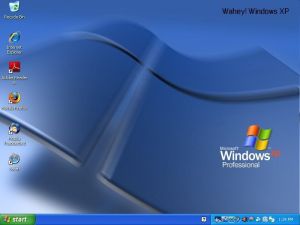Windows XP has run it’s duration and Microsoft have finally pulled support (I’m a bit late to this party). For those of us who are familiar with the operating system (if you’re not by now, then you’re even later to the party), this means very little, for everyone else it means that you don’t get the occasional OS security patch. So, really not much has changed, unless you happen to download a lot of malicious software or you frequently fly without a firewall in place.
Windows XP has been around for donkeys years now. It was released in 2001 and was really the only true follow-up to Windows ’98, which I was personally a huge fan of. Windows XP was pretty radical. In the time between ’98 and 2001, Windows seemed to finally catch up with the world. The OS was fast, stable, looked good, has lots of customisation and importantly, lots of scope for modification and to get under the bonnet. Since XP, Microsoft have slipped into reverse and are taking away more and more user control, piece by piece, in a similar guise to Apple. This isn’t what Windows users on the whole want, otherwise I feel, they’d be making a quick visit to the Apple Store. Thankfully, Microsoft seem to be undoing some of the horror-show parts of Windows 8 with 8.1 and it’s even more recent update. But however you look at it, XP is still pretty special, hence the reason it survived for so long.
Pre-XP

Although I’m all for XP, I for one am a big fan of PC operating systems, before it came to be.
If you’re looking for an OS that’s light on system resources, you can’t really get any better than good ol’ DOS (Who remembers “Loading Himem.sys”?). Whether it’s MS-DOS or it’s PC-DOS incarnation, it was absolutely lovely. I remember spending a fair amount of time writing Batch files to do all sorts of things. I also fondly remember being knee deep in the autoexec.bat and config.sys files, whether it was configuring Sound Blaster drivers or making sure the CD-ROM drivers were loaded, it was a great introduction to personal computing, and I feel bad for kids today who have simply missed out on these “pleasures” that would set you up for future PC related challenges.
Windows 3.1

Ignoring it’s previous incarnations, Windows 3.1/3.11 was when the GUI really started to take off for PCs. It was pretty useless for running games through; that required a swift exit to DOS, unless you wanted your game to run like an absolute dog. But Windows 3.1 had a solid library of productivity software and utilities. Don’t get me wrong, there were certainly games for the OS, but they most were DOS based, and much better for it.
Windows ’95

Next up was Windows ’95. At the time it seemed like the biggest overhaul known to man, even though IBM’s OS/2 already contained a lot of similar features. The desktop worked differently to 3.1, Program Manager was gone and there was this strange thing called a “Start” menu (which I tried to recreate in Windows 3.1 using Visual Basic). I can’t actually recall how I got my hands on Windows ’95, but I’m fairly certain it wasn’t through the authorised channels. But anyway, things changed from this point onwards. 640×480 wasn’t really a suitable resolution any more, it was time to reach the heady heights of 800×600 or even 1024×768, if you had a top spec. monitor, that could display the resolution without a mega-tonne of flicker (i.e. less than 60hz refresh). DOS games could load a little better in Windows, but you still needed to exit to DOS to get the most from them. Exiting to DOS took longer, and you still needed to load all the drivers in Autoexec.bat and Config.sys, so in that respect, things weren’t too different. But the potential for the new OS was clear, especially with the introduction of Direct X…
Windows ’98

Windows ’98 started to use Direct X to it’s potential, and it was much more common to now run games straight from Windows. With the Direct X 3D capability, this wasn’t as bad as it felt to the DOS lovers amongst us. Plus the dawn of new hardware and 686 processors certainly helped speed things along. Windows ’98 had a lovely new screens on installation, but looked pretty much the same as ’95 when it came to usage. I must admit, I did like the startup screen though. Take a look at me trying to wedge it in a more modern machine here.
Windows ME, 2000, etc, etc…
Windows XP and beyond

And then that brings us to the revolutionary Windows XP. This is when the internet was really a mainstream service, and the operating system was built to show this. By today’s standards, it’s pretty unconnected, but it was good enough to set the standard for subsequent OSes (including Vista…) and has lasted this long so far.
May it continue to be used by PCs around the globe for many years to come, regardless of security updates.
DOS image courtesy of: en.wikipedia.org/wiki/IBM_PC_DOS

Nostalgia Nerd is also known by the name Peter Leigh. They routinely make YouTube videos and then publish the scripts to those videos here. You can follow Nostalgia Nerd using the social links below.





